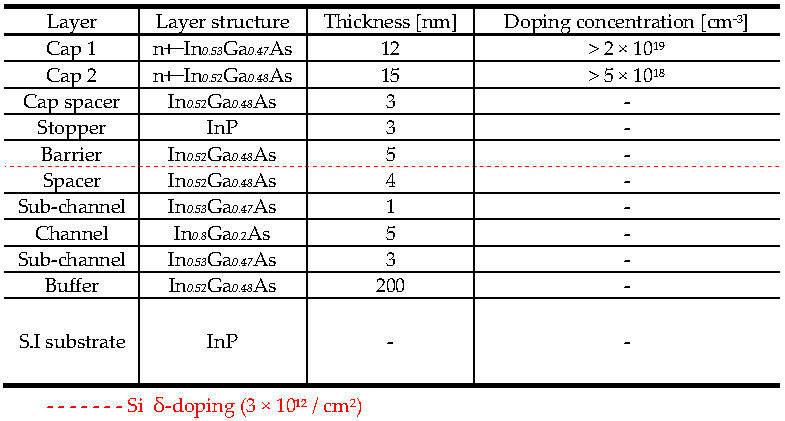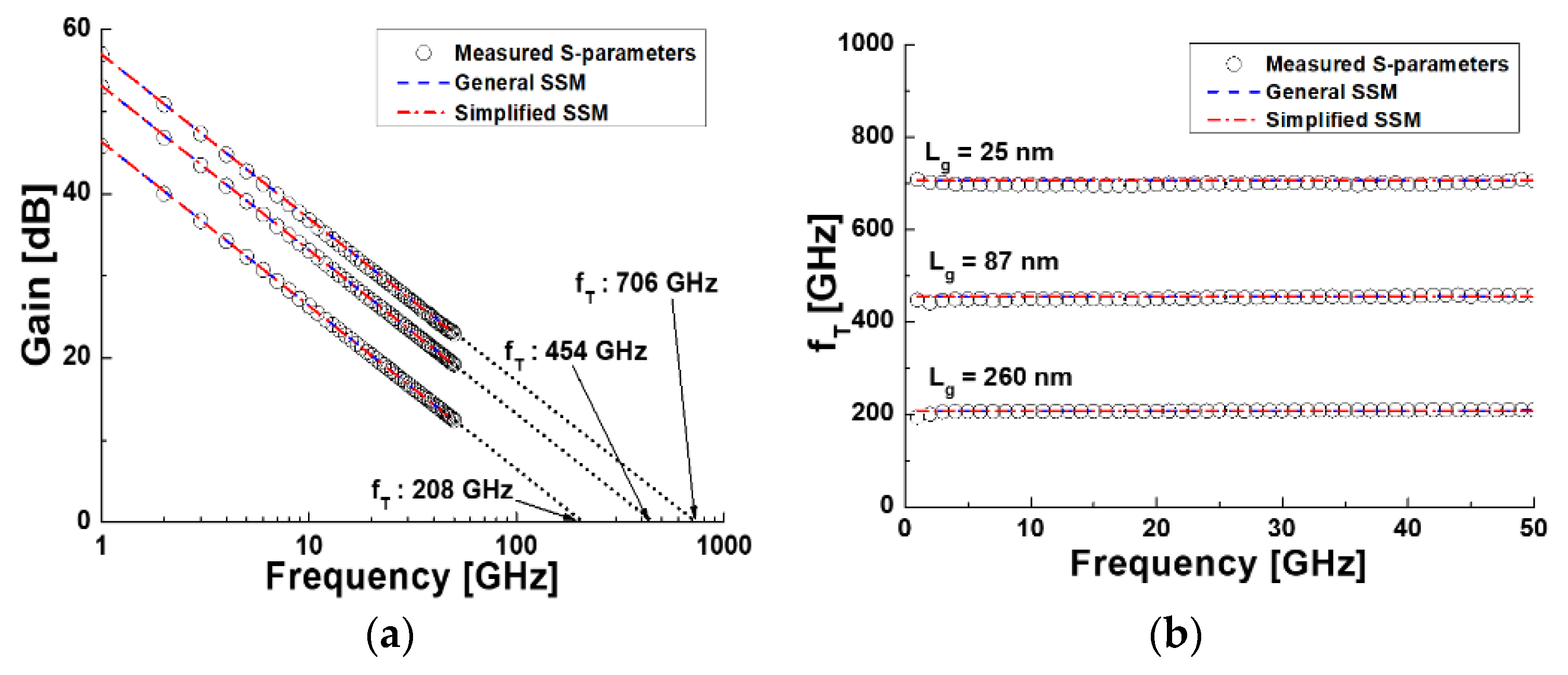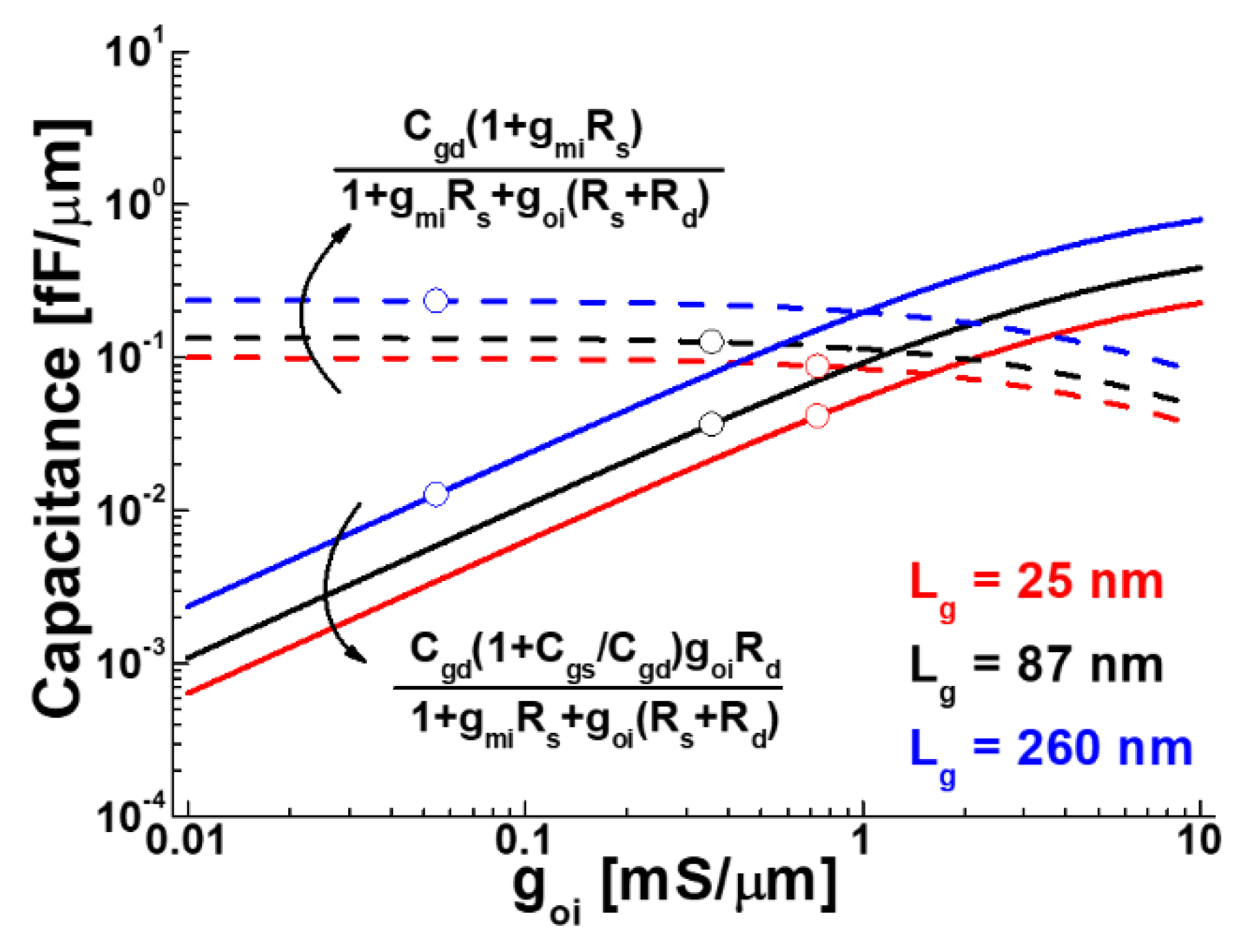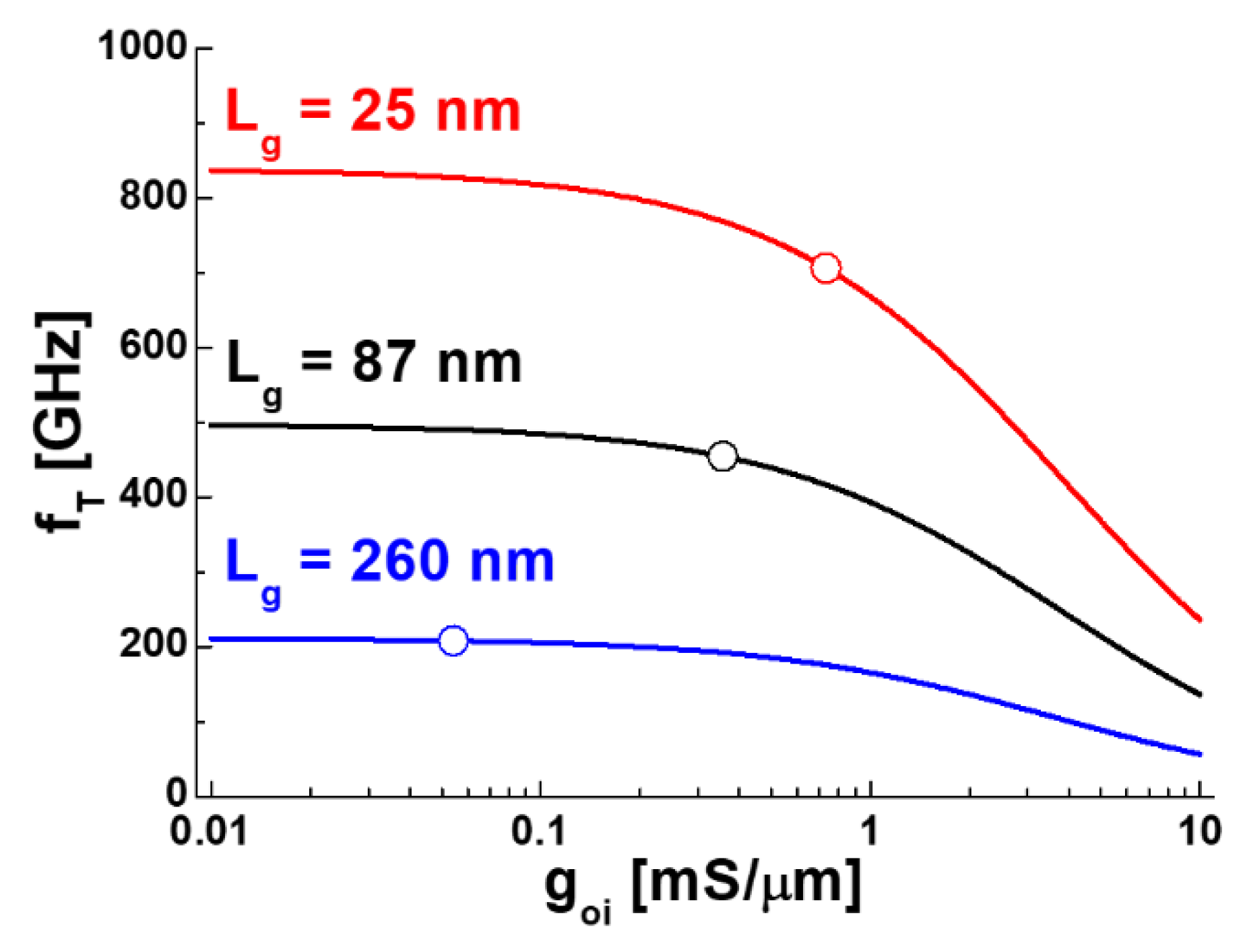Impact of Output Conductance on Current-Gain Cut-Off Frequency in InxGa1-xAs/In0.52Al0.48As Quantum-Well High-Electron-Mobility Transistors on InP Substrate
Abstract
:1. Introduction
2. Fabrication Process
3. Theoretical Analysis of fT
4. Results and Discussion
5. Conclusions
Author Contributions
Funding
Data Availability Statement
Acknowledgments
Conflicts of Interest
References
- Hornibrook, J.M.; Colless, J.I.; Lamb, I.D.C.; Pauka, S.J.; Lu, H.; Gossard, A.C.; Watson, J.D.; Gardner, G.C.; Fallahi, S.; Manfra, M.J.; et al. Cryogenic Control Architecutre for Large-Scale Quantum Computing. Phys. Rev. Appl. 2015, 3, 024010. [Google Scholar] [CrossRef] [Green Version]
- Leong, K.M.H.; Mei, X.; Yoshida, W.H.; Zamora, A.; Padilla, J.G.; Gorospe, B.S.; Nguyen, K.; Deal, W.R. 850 GHz receiver and transmitter front-end using InP HEMT. IEEE Trans. Terahertz Sci. Technol. 2017, 7, 466. [Google Scholar] [CrossRef]
- Deal, W.R.; Leong, K.; Zamora, A.; Gorospe, B.; Nguyen, K.; Mei, X.B. A 660 GHz up-converter for THz communications. In Proceedings of the IEEE Compound Semiconductor Integrated Circuit Symposium (CSICS), Miami, FL, USA, 22–25 October 2017. [Google Scholar]
- Tessmann, A.; Leuther, A.; Wagner, S.; Massler, H.; Kuri, M.; Stulz, H.-P.; Zink, M.; Riessle, M.; Merkle, T. A 300 GHz low-noise amplifier S-MMIC for use in next-generation imaging and communication applications. In Proceedings of the IEEE MTT-S International Microwave Symposium (IMS), Honololu, HI, USA, 4–9 June 2017; p. 760. [Google Scholar]
- Ajayan, J.; Nirmal, D. A review of InP/InAlAs/InGaAs based transistors for high frequency applications. Superlattices Microstruc. 2015, 86, 1. [Google Scholar] [CrossRef]
- Rodwell, M.J.W.; Lee, S.; Huang, C.-Y.; Elias, D.; Chobpattanna, V.; Rode, J.; Chiang, H.-W.; Choudhary, P.; Maurer, R.; Urteaga, M.; et al. Nanometer InP electron devices for VLSI and THz applications. In Proceedings of the 72nd Annual Device Research Conference (DRC 2014), Santa Barbara, CA, USA, 22–25 June 2014; p. 215. [Google Scholar]
- Kim, D.-H.; Brar, B.; del Alamo, J.A. fT = 688 GHz and fmax = 800 GHz in Lg = 40 nm In0.7Ga0.3As MHEMTs with gm_max > 2.7 mS/µm. In Proceedings of the 2011 International Electron Devices Meeting, Washington, DC, USA, 5–7 December 2011; pp. 13.6.1–13.6.4. [Google Scholar]
- Kim, D.-H.; del Alamo, J.A. 30 nm InAs PHEMTs with ft=644 and fmax=681 GHz. IEEE Electron Device Lett. 2010, 31, 806. [Google Scholar]
- Kim, D.-H.; del Alamo, J.A. 30 nm E-mode InAs PHEMTs for THz and future logic application. IEEE Electron Device Lett. 2008, 29, 830. [Google Scholar] [CrossRef]
- Lai, R.; Mei, X.B.; Deal, W.R.; Yoshida, W.; Kim, Y.M.; Liu, P.H.; Lee, J.; Uyeda, J.; Radisic, V.; Lange, M.; et al. Sub 50 nm InP HEMT Device with fmax greater than 1 THz. In Proceedings of the 2007 IEEE International Electron Devices Meeting, Washington, DC, USA, 10–12 December 2007; pp. 609–611. [Google Scholar]
- Suemitsu, T.; Ishii, T.; Yokoyama, H.; Enoki, T.; Ishii, Y.; Tamamura, T. 30-nm-Gate InP-Based Lattice-Matched High Electron Mobility Transistors with 350 GHz Cutoff Frequency. Jpn. J. Appl. Phys. 1999, 38, 154. [Google Scholar] [CrossRef]
- Leuther, A.; Tessmann, A.; Dammann, M.; Massler, H.; Schlechtweg, M.; Ambacher, O. 35 nm mHEMT technology for THz and ultra low noise applications. In Proceedings of the 2013 International Conference on Indium Phosphide and Related Materials (IPRM), Kobe, Japan, 19–23 May 2013; pp. 1–2. [Google Scholar] [CrossRef]
- Kurita, Y.; Ducournau, G.; Coquillat, D.; Satou, A.; Kobayashi, K.; Boubanga Tombet, S.; Meziani, Y.M.; Popov, V.V.; Knap, W.; Suemitsu, T.; et al. Ultrahigh sensitive sub-terahertz detection by InP-based asymmetric dual-grating-gate high-electron-mobility transistors and their broadband characteristics. Appl. Phys. Lett. 2014, 104, 251114. [Google Scholar] [CrossRef] [Green Version]
- Radisic, V.; Leong, K.M.; Mei, X.; Sarkozy, S.; Yoshida, W.; Deal, W.R. Power amplification at 0.65 THz using INP HEMTs. IEEE Trans. Microw. Theory Tech. 2012, 60, 724. [Google Scholar] [CrossRef]
- Yeon, S.-J.; Par, M.-H.; Choi, J.; Seo, K.-S. 610 GHz InAlAs/In0.75Ga0.25As Metamorphic HEMTs with an Ultra-Short 15-nm-Gate. In Proceedings of the 2007 IEEE International Electron Devices Meeting, Washington, DC, USA, 10–12 December 2007; pp. 613–616. [Google Scholar]
- Watanabe, T.; Boubanga-Tombet, S.A.; Tanimoto, Y.; Fateev, D.; Popov, V.; Coquillat, D.; Knap, W.; Meziani, Y.M.; Wang, Y.; Minamide, H.; et al. InP- and GaAs-Based Plasmonic High-Electron-Mobility Transistors for Room-Temperature Ultrahigh-Sensitive Terahertz Sensing and Imaging. IEEE Sens. J. 2013, 13, 89–99. [Google Scholar] [CrossRef]
- Chang, E.-Y.; Kuo, C.-I.; Hsu, H.-T.; Chiang, C.-Y.; Miyamoto, Y. InAs Thin-Channel High-Electron-Mobility Transistors with Very High Current-Gain Cutoff Frequency for Emerging Submillimeter-Wave Applications. Appl. Phys. Exp. 2013, 6, 034001. [Google Scholar] [CrossRef]
- Jo, H.-B.; Yun, D.-Y.; Baek, J.-M.; Lee, J.-H.; Kim, T.-W.; Kim, D.-H.; Tsutsumi, T.; Sugiyama, H.; Matsuzaki, H. Lg = 25 nm InGaAs/InAlAs high-electron mobility transistors with both fT and fmax in excess of 700 GHz. Appl. Phys. Exp. 2019, 12, 054006. [Google Scholar] [CrossRef]
- Rodrigues, I.H.; Niepce, D.; Pourkabirian, A.; Moschetti, G.; Schleeh, J.; Bauch, T.; Grahn, J. On the angular dependence of InP high electron mobility transistors for cryogenic low noise amplifiers in a magnetic field. AIP Adv. 2019, 9, 085004. [Google Scholar] [CrossRef] [Green Version]
- Takahashi, T.; Kawano, Y.; Makiyama, K.; Shiba, S.; Sato, M.; Nakasha, Y.; Hara, N. vEnhancement of fmax to 910 GHz by adopting asymmetric gate recess and double-side-doped structure in 75-nm-gate InAlAs/InGaAs HEMTs. IEEE Trans. Electron Devices 2017, 64, 89. [Google Scholar] [CrossRef]
- Sugiyama, H.; Hoshi, T.; Yokoyama, H.; Matsuzaki, H. Metal-organic vapor-phase epitaxy growth of InP-based HEMT structures with InGaAs/InAs composite channel. In Proceedings of the 2012 International Conference on Indium Phosphide and Related Materials, Santa Barbara, CA, USA, 27–30 August 2012; pp. 245–248. [Google Scholar]
- Yun, D.-Y.; Jo, H.-B.; Son, S.-W.; Baek, J.-M.; Lee, J.-H.; Kim, T.-W.; Kim, D.-H.; Tsutsumi, T.; Sugiyama, H.; Matsuzaki, H. Impact of the source-to-drain spacing on the DC and RF characteristics of InGaAs/InAlAs high-electron mobility transistors. IEEE Electron Device Lett. 2018, 39, 1844. [Google Scholar] [CrossRef]
- Ajayan, J.; Nirmal, D. 20 nm high performance enhancement mode InP HEMT with heavily doped S/D regions for future THz applications. Superlattices Microstruc. 2016, 100, 526. [Google Scholar] [CrossRef]
- Li, Z.; An, N.; Zeng, J.; Tong, X.; Wang, W.; Li, Q.; Liu, H.; Liang, Y.; Tang, H.; Xiong, Y.-Z. Studying on source/drain contact resistance reduction for InP-based HEMT. Microw. Opt. Technol. Lett. 2016, 58, 217. [Google Scholar] [CrossRef]
- Takahashi, T.; Makiyama, K.; Hara, N.; Sato, M.; Hirose, T. Improvement in high frequency and noise characteristics of InP based HEMTs by reducing parasitic capacitance. In Proceedings of the 2008 20th International Conference on Indium Phosphide and Related Materials, Versailles, France, 25–29 May 2008; pp. 1–4. [Google Scholar]
- Shinohara, K.; Tamashita, Y.; Endoh, A.; Watanabe, I.; Hikosaka, K.; Matsui, T.; Mimura, T.; Hiyamizu, S. 547-GHz ft In 0.7Ga0.3As-In0.52Al0.48As HEMTs with reduced source and drain resistance. IEEE Electron Device Lett. 2004, 25, 241. [Google Scholar] [CrossRef]
- Shinohara, K.; Yamashita, Y.; Endoh, A.; Watanabe, I.; Hikosaka, K.; Mimura, T.; Hiyamizu, S.; Matsui, T. “550 GHz- pseudomorphic InP-HEMTs with reduced source/drain resistance. In Proceedings of the 61st Device Research Conference. Conference Digest, Salt Lake City, UT, USA, 23–25 June 2003; pp. 145–146. [Google Scholar]
- Makiyama, K.; Takahashi, T.; Suzuki, T.; Sawada, K.; Ohki, T.; Nishi, M.; Hara, N.; Takikawa, M. Improvement of circuit-speed of HEMTs IC by reducing the parasitic capacitance. In Proceedings of the IEEE International Electron Devices Meeting 2003, Washington, DC, USA, 8–10 December 2003; pp. 30–36. [Google Scholar]
- Yue, Y.; Hu, Z.; Guo, H.; Sensale-Rodiriguez, B.; Li, G.; Wang, R.; Faria, F.; Fang, T.; Song, B.; Gao, X.; et al. InAlN/AlN/GaN HEMTs With Regrown Ohmic Contacts and fT of 370 GHz. IEEE Electron Device Lett. 2012, 33, 988. [Google Scholar] [CrossRef]
- Shinohara, K.; Corrion, A.; Regan, D.; Milosavljevic, I.; Brown, D.; Burnham, S.; Willadsen, P.J.; Butler, C.; Schmitz, A.; Wheeler, D.; et al. 220GHz fT and 400GHz fmax in 40-nm GaN DH-HEMTs with re-grown ohmic. In Proceedings of the 2010 International Electron Devices Meeting, San Francisco, CA, USA, 6–8 December 2010; pp. 30–31. [Google Scholar]
- Akagawa, K.; Fukuda, S.; Suemitsu, T.; Otsuji, T.; Yokohama, H.; Araki, G. Impact of T-gate electrode on gate capacitance in In0.7Ga0.3As HEMTs. Phys. Status Solidi C 2011, 8, 300. [Google Scholar] [CrossRef]
- Kim, D.-H.; del Alamo, A.; Lee, J.-H.; Seo, K.-S. Logic Suitability of 50-nm In0.7Ga0.3As HEMTs for Beyond-CMOS Applications. IEEE Trans. Electron Devices 2007, 54, 2606. [Google Scholar] [CrossRef]
- Chau, R.; Datta, S.; Doczy, M.; Doyle, B.; Jin, B.; Kavalieros, J.; Majumdar, A.; Metz, M.; Radosavljevic, M. Benchmarking nanotechnology for high-performance and low-power logic transistor applications. IEEE Trans. Nanotechnol. 2005, 4, 153. [Google Scholar] [CrossRef]
- Park, W.-S.; Jo, H.-B.; Kim, H.-J.; Choi, S.-M.; Yoo, J.-H.; Kim, J.-H.; Jeong, H.-S.; George, S.; Beak, J.-M.; Lee, I.-G.; et al. Sub-50 nm Terahertz In0.8Ga0.2As quantum-well High-Electron-Mobility transistors for 6G applications. In Proceedings of the IEEE International Electron Devices Meeting, San Francisco, CA, USA, 3–7 December 2022; p. 258. [Google Scholar]
- Tasker, P.J.; Hughes, B. Importance of source and drain resistance to the maximum fT of millimeter-wave MODFETs. IEEE Electron Device Lett. 1989, 10, 291. [Google Scholar] [CrossRef]
- Moll, N.; Hueschen, M.R.; Fischer-Colbrie, A. Pulse-doped AlGaAs/InGaAs pseudomorphic MODFETs. IEEE Trans. Electron Devices 1988, 35, 879. [Google Scholar] [CrossRef]
- Del Alamo, J.A.; Kim, D.-H. III-V’s: From THz HEMTs to CMOS. In Proceedings of the 2009 Topical Workshop on Heterostructure Microelectronics, Nagano, Japan, 25–28 August 2009. [Google Scholar]
- Suemitsu, T. An intrinsic delay extraction method for Schottky gate field effect transistors. IEEE Electron Device Lett. 2004, 25, 669. [Google Scholar] [CrossRef]
- Wang, H.; Hsu, A.; Lee, D.S.; Kim, K.K.; Kong, J.; Palacios, T. Delay Analysis of Graphene Field-Effect Transistors. IEEE Electron Device Lett. 2012, 33, 324. [Google Scholar] [CrossRef] [Green Version]
- Lee, D.S.; Gao, X.; Guo, S.; Kopp, D.; Fay, P.; Palacios, T. 300-GHz InAlN/GaN HEMTs With InGaN Back Barrier. IEEE Electron Device Lett. 2011, 32, 1525. [Google Scholar] [CrossRef]
- Minasian, R.A. Simplified GaAs mesfet model to 10 GHz. Electron Lett. 1977, 13, 549. [Google Scholar] [CrossRef]
- Dambrine, G.; Cappy, A.; Heliodore, F.; Playez, E. A new method for determining the FET small-signal equivalent circuit. IEEE Trans. Microwave Theory Tech. 1988, 36, 1151. [Google Scholar] [CrossRef]
- Chou, S.Y.; Antoniadis, D.A. Relationship between measured and intrinsic transconductances of FET’s. IEEE Trans. Electron Devices 1987, 34, 448. [Google Scholar] [CrossRef]







| General SSM | Simplified SSM | |||||||||
|---|---|---|---|---|---|---|---|---|---|---|
| Lg (nm) | gmi (mS/μm) | goi (mS/μm) | Cgs (fF/μm) | Cgd (fF/μm) | Cds (fF/μm) | gm_ext (mS/μm) | go_ext (mS/μm) | Cgs_ext (fF/μm) | Cgd_ext (fF/μm) | Cds_ext (fF/μm) |
| 260 | 3.5 | 0.05 | 2.15 | 0.24 | 0.11 | 2.26 | 0.04 | 1.48 | 0.25 | 0.06 |
| 87 | 4.25 | 0.36 | 1.05 | 0.14 | 0.09 | 2.42 | 0.20 | 0.68 | 0.16 | 0.03 |
| 25 | 4.43 | 0.74 | 0.61 | 0.1 | 0.23 | 2.33 | 0.39 | 0.40 | 0.13 | 0.13 |
| Using a Least-Square Fit from 1 to 50 GHz | Using Analytical Equations (GHz) | |||
|---|---|---|---|---|
| Lg (nm) | From Measured S Parameters | From the General SSM | From the Simplified SSM | From Equation (7) |
| 260 | 207 | 207 | 207 | 207 |
| 87 | 453 | 454 | 454 | 454 |
| 25 | 703 | 706 | 706 | 706 |
Disclaimer/Publisher’s Note: The statements, opinions and data contained in all publications are solely those of the individual author(s) and contributor(s) and not of MDPI and/or the editor(s). MDPI and/or the editor(s) disclaim responsibility for any injury to people or property resulting from any ideas, methods, instructions or products referred to in the content. |
© 2023 by the authors. Licensee MDPI, Basel, Switzerland. This article is an open access article distributed under the terms and conditions of the Creative Commons Attribution (CC BY) license (https://creativecommons.org/licenses/by/4.0/).
Share and Cite
Kim, H.-J.; Lee, I.-G.; Jo, H.-B.; Rho, T.-B.; Tsutsumi, T.; Sugiyama, H.; Matsuzaki, H.; Lee, J.-H.; Kim, T.-W.; Kim, D.-H. Impact of Output Conductance on Current-Gain Cut-Off Frequency in InxGa1-xAs/In0.52Al0.48As Quantum-Well High-Electron-Mobility Transistors on InP Substrate. Electronics 2023, 12, 259. https://doi.org/10.3390/electronics12020259
Kim H-J, Lee I-G, Jo H-B, Rho T-B, Tsutsumi T, Sugiyama H, Matsuzaki H, Lee J-H, Kim T-W, Kim D-H. Impact of Output Conductance on Current-Gain Cut-Off Frequency in InxGa1-xAs/In0.52Al0.48As Quantum-Well High-Electron-Mobility Transistors on InP Substrate. Electronics. 2023; 12(2):259. https://doi.org/10.3390/electronics12020259
Chicago/Turabian StyleKim, Hyo-Jin, In-Geun Lee, Hyeon-Bhin Jo, Tae-Beom Rho, Takuya Tsutsumi, Hiroki Sugiyama, Hideaki Matsuzaki, Jae-Hak Lee, Tae-Woo Kim, and Dae-Hyun Kim. 2023. "Impact of Output Conductance on Current-Gain Cut-Off Frequency in InxGa1-xAs/In0.52Al0.48As Quantum-Well High-Electron-Mobility Transistors on InP Substrate" Electronics 12, no. 2: 259. https://doi.org/10.3390/electronics12020259






